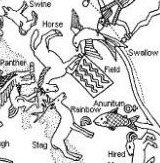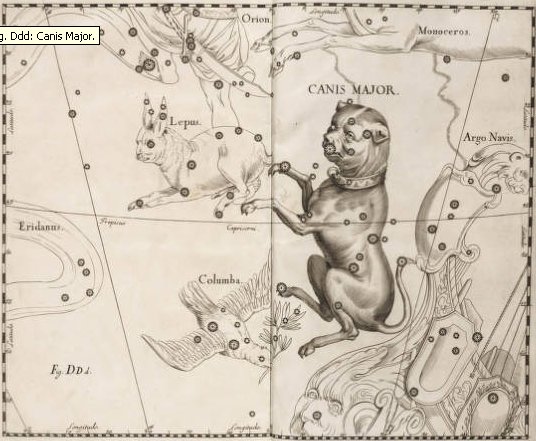185. The beginning of the
year should be when Sun began to return,
to come alive again after the winter
solstice, and south of the equator this
could
once upon a time have been
after the conjunction when Sun
and Moon both had reached day 420 -
as reflected in the face of the Full Moon.
At the time of Betelgeuze
(when this star had been at 0h) the
heliacal position of the
Foundation Stone (Temennu, Alcyone) had been
in day 52 (as counted from 1 January) + 11
(distance from 21 December to 1 January) =
63 (= 9 * 7), and this number we can recognize from
the G text, where instead it evidently marked the
precessional time down to the Rainy Hyades -
which were at the end of side b of the
tablet in order to have the correct position
of the March equinox 64 (= 8 * 8) days
earlier. Betelgeuze (*88) - Alcyone (*56) =
32 = 64 / 2 = the number of cowries on the
hands and feet of the buried Lébé:
...
Easter Island (te pito o te kainga)
is the last of all known islands. Seven
lands lie before it, but these do not
recommend themselves for settlement.
Easter Island is the 'eighth land' (te
varu kainga). Actually, we are dealing
here with a figure of speech because 'seven'
and 'eight' used as qualifying quantities
play a traditional role in Oceania (Barthel
1962a). While the number seven is known as a
topos in MQS., HAW., and MAO., the topos of
the number eight goes far beyond eastern
Polynesia (MQS., HAW., TAH.).
In TON., the number eight is 'a conventional
term signifying many or a well-balanced
number' (McKern 1929:17), and on Malaita in
the southern Solomon Islands, the physical
world in its entirety is referred to as
'eight islands (wālu malau) (Ivens
1927:400). The number eight not only means
'many' but also denotes perfection. Thus,
when Easter Island was called 'an eighth
land', the expression contained first of all
the idea of a 'last' island - an island
farthest away from the rest of the islands
that make up the oceanic world. At the same
time, the expression indicated a special
position among the other islands. The idea
of groups of seven, which are surpassed by
an eight element, seems to belong to the
cosmology of Asian high cultures. For
example, there are seven planets circling
the world axis, which represents the eighth,
and therefore central, position ...
...
Ogotemmêli had his own ideas about
calculation. The Dogon in fact did use the
decimal system, because from the beginning
they had counted on their fingers, but the
basis of their reckoning had been the number
eight and this number recurred in what they
called in French la centaine, which
for them meant eighty. Eighty was the limit
of reckoning, after which a new series
began. Nowadays there could be ten such
series, so that the European 1,000
corresponded to the Dogon 800.
But Ogotemmêli believed that in the
beginning men counted by eights - the number
of cowries on each hand, that they had used
their ten fingers to arrive at eighty, but
that the number eight appeared again in
order to produce 640 (8 x 10 x 8). 'Six
hundred and forty', he said, 'is the end of
the reckoning.' According to him, 640
covenant-stones had been thrown up by the
seventh Nummo to make the outline in the
grave of Lébé.

So the cowries that the father of the first
twins found in the ground when harvesting
millet after the second sowing, were a
foreshadowing of commerce
...

 |
 |
 |
 |
|
Cb2-4 (420 = 285 + 135) |
Cb2-5 (392 + 29) |
Cb2-6 (30) |
Cb2-7 (423) |
|
te ua |
koia ra |
kua tuku ki to
mata - ki tona tukuga |
e kiore
- henua - pa rei |
|
INVISIBLY CLOSE TO THE SUN NORTH
OF THE EQUATOR: |
|
π Cor.
Borealis,
UNUK ELHAIA
(Necks of the Serpents)
= λ Serpentis
(238.1),
CHOW = β Serpentis
(238.6) |
κ
Serpentis
(239.3), δ Cor. Borealis,
TIĀNRŪ = μ Serpentis
(239.5), χ Lupi, (239.6), ω
Serpentis (239.7),
BA = ε Serpentis,
χ Herculis (239.8).
κ
Cor. Borealis,
ρ Serpentis (239.9) |
λ Librae (240.0), β Tr. Austr.
(240.3), κ Tr. Austr. (240.4), ρ
Scorpii (240.8) |
Iklīl al Jabhah-15 (Crown of the
Forehead) /
Anuradha-17
(Following rādhā) /
Room-4 (Hare)
ξ Lupi, λ Cor. Bor.(241.1),
ZHENG = γ Serpentis,
θ Librae (241.2),
VRISCHIKA
= π Scorpii
(241.3), ε Cor. Borealis
(241.5), DSCHUBBA
(Front of Forehead) = δ Scorpii
(241.7), η Lupi (241.9) |
|
Egyptian hand |
 |
Phoenician
kaph |
 |
Greek
kappa |
Κ (κ) |
|
Kaph is
thought to have
been derived
from a pictogram
of a hand (in
both modern
Arabic and
modern Hebrew,
kaph
means palm/grip)
...
... The manik,
with the tzab,
or serpent's
rattles as
prefix, runs
across Madrid
tz. 22 , the
figures in the
pictures all
holding the
rattle; it runs
across the
hunting scenes
of Madrid tz.
61, 62, and
finally appears
in all four
clauses of tz.
175, the
so-called
'baptism'
tzolkin. It
seems
impossible, with
all this, to
avoid assigning
the value of
grasping or
receiving. But
in the final
confirmation, we
have the direct
evidence of the
signs for East
and West. For
the East we have
the glyph
Ahau-Kin,
the Lord Sun,
the Lord of Day;
for the West we
have
Manik-Kin,
exactly
corresponding to
the term
Chikin, the
biting or eating
of the Sun,
seizing it in
the mouth.



The pictures
(from Gates)
show east,
north, west, and
south;
respectively
(the lower two
glyphs) 'Lord'
(Ahau)
and 'grasp' (Manik).
Manik was
the 7th day sign
of the 20 and
Ahau the
last
... |
|
|
Nov 14 |
15 |
16 (320 = 137 + 183) |
17 (*241 = *58 + *183) |
|
ºNov 10 (314) |
11 |
12 |
13 (*237) |
|
'Oct 18 (108 + 183 = 291) |
19 |
20 |
21 (*214 =*31 + *183) |
|
"Oct 4 (277 = 314 - 37) |
5 |
6 |
7 (*200 = *17 + *183) |
|
SEPT 11
(254 = 71 + 183) |
12 (365 - 100) |
13 |
14 (*177 = *354 / 2) |
|
234 = 314 - 80 |
235 |
236 = 320 - 84 |
237 (= 8 * 29½ + 1) |

Kiore.
Rat. Vanaga.
Rat, mouse;
kiore hiva, rabbit. P Pau.,
Mgv.: kiore, rat, mouse.
Mq.: kioē, íoé,
id. Ta.: iore, id.
Churchill. |
|
... All was now ready for
departure except that there was
no fire in the smithy. The
ancestor slipped into the
workshop of the great Nummo, who
are Heaven's smiths, and stole a
piece of the sun in the form of
live embers and white-hot iron.
He seized it by means of a
'robber's stick' the crook of
which ended in a slit, open like
a mouth. He dropped some of the
embers, came back to pick them
up, and fled towards the
granary; but his agitation was
such that he could no longer
find the entrances. He made the
round of it several times before
he found the steps and climbed
onto the flat roof, where he hid
the stolen goods in one of the
skins of the bellows,
exclaiming: 'Gouyo!',
which is to say. 'Stolen!'. The
word is still part of the
language, and means 'granary'.
It is a reminder that without
the fire of the smithy and the
iron of hoes there would be no
crops to store
...

During his descent the ancestor
still possessed the quality of a
water spirit, and his body,
though preserving its human
appearance, owing to its being
that of a regenerated man, was
equipped with four flexible
limbs like serpents after the
pattern of the arms of the Great
Nummo. The ground was rapidly
approaching. The ancestor was
still standing, his arms in
front of him and the hammer and
anvil hanging across his limbs.
The shock of his final impact on
the earth when he came to the
end of the rainbow, scattered in
a cloud of dust the animals,
vegetables and men disposed on
the steps. When calm was
restored, the smith was still on
the roof, standing erect facing
towards the north, his tools
still in the same position. But
in the shock of landing the
hammer and the anvil had broken
his arms and legs at the level
of elbows and knees, which he
did not have before.

He thus acquired the joints
proper to the new human form,
which was to spread over the
earth and to devote itself to
toil
...
 |
|
May 16 (136) |
|
|
CLOSE TO THE FULL MOON
ON EASTER ISLAND: |
|
Al Thurayya-27 (Many Little
Ones) /
Krittikā-3 (Nurses of
Kārttikeya)
/
TAU-ONO
(Six Stones)
ATIKS = ο Persei, RANA (Frog) =
δ Eridani
(55.1),
CELAENO (16 Tauri), ELECTRA
(17), TAYGETA (19),
ν
Persei (55.3),
MAIA (20), ASTEROPE (21), MEROPE
(23)
(55.6) |
Hairy Head-18
(Cockerel) /
Temennu-3
(Foundation Stone)
ALCYONE
(56.1),
PLEIONE
(28 Tauri),
ATLAS
(27)
(56.3) |
MENKHIB = ζ Persei
(57.6)
PORRIMA (γ Virginis)
|
ZAURAK
(The Boat) = γ Eridani
(58.9) |
|
15 (135 + 365 = 500) |
May 16 (136) |
17 |
18 (*58) |
|
ºMay 11 |
12 (132) |
13 |
14 (*54) |
|
4-18 (473
= 108 + 365) |
'April 19 |
4-20 |
21 (111) |
|
"April 4 |
5 (501 - 41 = 460) |
6 (*16) |
7 |
|
MARCH 12 |
13 |
3-14 (73) |
15 |
|
417 (= 501 - 84) |
52 |
53 (= 73 - 20) |
54 (= *58 - 4) |
|
... The Mahabharata
insists on six as the
number of the Pleiades as well
as of the mothers of Skanda
and gives a very broad and wild
description of the birth and the
installation of Kartikeya
'by the assembled gods ... as
their generalissimo', which is
shattering, somehow, driving
home how little one understands
as yet. The least which can be
said, assuredly: Mars was
'installed' during a more or
less close conjunction of all
planets; in Mbh. 9.45 (p. 133)
it is stressed that the powerful
gods assembled 'all poured water
upon Skanda, even as the
gods had poured water on the
head of Varuna, the lord
of waters, for investing him
with dominion'. And this
'investiture' took place at the
beginning of the Krita Yuga,
the Golden Age
... |
|
... They go inland at the land.
The child nursed and tended
grows up, is able to go and
play. Each day he now goes off a
bit further away, moving some
distance away from the house,
and then returns to their house.
So it goes on and the child is
fully grown and goes to play far
away from the place where they
live. He goes over to where some
work is being done by a father
and son. Likāvaka is the
name of the father - a
canoe-builder, while his son is
Kiukava.
Taetagaloa
goes right over there and steps
forward to the stern of the
canoe saying - his words are
these: 'The canoe is crooked.'
(kalo
ki ama).
Instantly Likāvaka is
enraged at the words of the
child. Likāvaka says:
'Who the hell are you to come
and tell me that the canoe is
crooked?'
Taetagaloa
replies: 'Come and stand over
here and see that the canoe is
crooked.' Likāvaka goes
over and stands right at the
place Taetagaloa told him
to at the stern of the canoe.
Looking forward, Taetagaloa
is right, the canoe is crooked.
He slices through all the
lashings of the canoe to
straighten the timbers. He
realigns the timbers. First he
must again position the
supports, then place the timbers
correctly in them, but
Kuikava the son of
Likāvaka goes over and
stands upon one support. His
father Likāvaka rushes
right over and strikes his son
Kuikava with his adze.
Thus Kuikava dies.
Taetagaloa
goes over at once and brings the
son of Likāvaka,
Kuikava, back to life. Then
he again aligns the supports
correctly and helps Likāvaka
in building the canoe. Working
working it is finished
... |
|
... They all sat down and rested
[on the plain of Oromanga],
when suddenly they saw that a
turtle had reached the shore and
had crawled up on the beach. He
[Ira] looked at it and
said, 'Hey, you! The turtle has
come on land!' He said, 'Let's
go! Let's go back to the shore.'
They all went to pick up the
turtle. Ira was the first
one to try to lift the turtle -
but she didn't move. Then
Raparenga said, 'You do not
have the necessary ability. Get
out of my way so that I can have
a try!' Raparenga stepped
up and tried to lift the turtle
- but Raparenga could not
move her. Now you spoke,
Kuukuu: 'You don't have the
necessary ability, but I shall
move this turtle. Get out of my
way!' Kuukuu stepped up,
picked up the turtle, using all
his strength. After he had
lifted the turtle a little bit,
he pushed her up farther. No
sooner had he pushed her up and
lifted her completely off the
ground when she struck Kuukuu
with one fin. She struck
downward and broke Kuukuu's
spine.The turtle got up, went
back into the (sea) water, and
swam away. All the kinsmen spoke
to you (i.e. Kuukuu):
'Even you did not prevail
against the turtle!'
They put the injured Kuukuu
on a stretcher and carried him
inland. They prepared a soft bed
for him in the cave and let him
rest there. They stayed there,
rested, and lamented the
severely injured Kuukuu.
Kuukuu said, 'Promise me,
my friends, that you will not
abandon me!' They all replied,
'We could never abandon
you!' They stayed there
twenty-seven days in Oromanga.
Everytime Kuukuu asked,
'Where are you, friends?' they
immediately replied in one
voice, 'Here we are!' They all
sat down and thought. They had
an idea and Ira spoke,
'Hey, you! Bring the round
stones (from the shore) and pile
them into six heaps of stones!'
One of the youths said to Ira,
'Why do we want heaps of stone?'
Ira replied, 'So that we
can all ask the stones to do
something.' They took (the
material) for the stone heaps (pipi
horeko) and piled up six
heaps of stone at the outer edge
of the cave. Then they all said
to the stone heaps, 'Whenever he
calls, whenever he calls for us,
let your voices rush (to him)
instead of the six (of us)
(i.e., the six stone heaps are
supposed to be substitutes for
the youths). They all drew back
to profit (from the deception)
(? ki honui) and
listened. A short while later,
Kuukuu called. As soon as
he had asked, 'Where are you?'
the voices of the stone heaps
replied, 'Here we are!' All (the
youths) said, 'Hey, you! That
was well done!'
... |
|
... Vainamoinen set about
building a boat, but when it
came to the prow and the stern,
he found he needed three words
in his rune that he did not
know, however he sought for
them. In vain he looked on the
heads of the swallows, on the
necks of the swans, on the backs
of the geese, under the tongues
of the reindeer. He found a
number of words, but not those
he needed. Then he thought of
seeking them in the realm of
Death, Tuonela, but in vain. He
escaped back to the world of the
living only thanks to his potent
magic. He was still missing his
three runes. He was then told by
a shepherd to search in the
mouth of Antero Vipunen, the
giant ogre. The road, he was
told, went over swords and
sharpened axes. Ilmarinen made
shoes, shirt and gloves of iron
for him, but warned him that he
would find the great Vipunen
dead. Nevertheless, the hero
went. The giant lay underground,
and trees grew over his head.
Vainamoinen found his way to the
giant's mouth, and
planted his iron staff in it.
The giant awoke and suddenly
opened his huge mouth.
Vainamoinen slipped into it and
was swallowed. As soon as he
reached the enormous stomach, he
thought of getting out. He built
himself a raft and floated on it
up and down inside the giant.
The giant felt tickled and told
him in many and no uncertain
words where he might go, but he
did not yield any runes. Then
Vainamoinen built a smithy and
began to hammer his iron on an
anvil, torturing the entrails of
Vipunen, who howled out magic
songs to curse him away. But
Vainamoinen said, thank you, he
was very comfortable and would
not go unless he got the secret
words. Then Vipunen at last
unlocked the treasure of his
powerful runes. Many days and
nights he sang, and the sun and
the moon and the waves of the
sea and the waterfalls stood
still to hear him. Vainamoinen
treasured them all and finally
agreed to come out. Vipunen
opened his great jaws, and the
hero issued forth to go and
build his boat at last
...
 |
In the G text we could perceive
a place where
the Stag might have brought fire from the sky
down to humanity:
 |
 |
 |
 |
 |
|
Ga1-22 |
Ga1-23 → 403 - 280 |
Ga1-24 |
Ga1-25 → 5 * 5 * 5 |
Ga1-26 |
 |
|
μ Columbae,
SAIPH
(Sword) = κ Orionis
(86.5), τ Aurigae, ζ Leporis
(86.6) |
υ Aurigae (87.1), ν Aurigae
(87.2),
WEZN
(Weight) = β Columbae,
δ Leporis (87.7),
TZE (Son) = λ Columbae
(87.9) |
Ardra-6 (The Moist One) /
ANA-VARU-8 (Pillar to
sit by)
χ¹ Orionis, ξ Aurigae
(88.1),
BETELGEUZE
= Α Orionis (88.3),
ξ Columbae (88.5), σ
Columbae (88.7)
ZUBEN ELGENUBI (α Librae)
|
η Leporis (89.0),
PRAJA-PĀTI
= Δ Aurigae, MENKALINAN = Β
Aurigae, MAHASHIM = Θ
Aurigae, and Γ Columbae
(89.3),
π Aurigae (89.4), η Columbae
(89.7) |
Μ Orionis (90.3),
χ² Orionis (90.5) |
|
June 15 |
16 |
17 (168) |
18 |
19 |
|
°June 11 |
12 |
13 (164) |
14 |
15 (*86) |
|
'May 19 |
20 |
21 (141) |
22 |
23 (*63) |
|
"May 5 |
6 |
7 (127) |
8 |
9 (*49) |
|
APRIL 12 |
13 |
14 (104) |
15 |
16 (*26) |
|
82 |
83 |
84 (= 12 * 7) |
85 (= 5 * 17) |
86 |
 |
|
A man had a daughter who
possessed a wonderful bow
and arrow, with which she
was able to bring down
everything she wanted. But
she was lazy and was
constantly sleeping. At this
her father was angry and
said: 'Do not be always
sleeping, but take thy bow
and shoot at the navel of
the ocean, so that we may
get fire.' The navel of the
ocean was a vast whirlpool
in which sticks for making
fire by friction were
drifting about. At that time
men were still without fire.
Now the maiden seized her
bow, shot into the navel of
the ocean, and the material
for fire-rubbing sprang
ashore.
Then the old man was glad.
He kindled a large fire, and
as he wanted to keep it to
himself, he built a house
with a door which snapped up
and down like jaws and
killed everybody that wanted
to get in. But the people
knew that he was in
possession of fire, and the
stag determined to steal it
for them. He took resinous
wood, split it and stuck the
splinters in his hair. Then
he lashed two boats
together, covered them with
planks, danced and sang on
them, and so he came to the
old man's house. He sang:
'O, I go and will fetch the
fire.' The old man's
daughter heard him singing,
and said to her father: 'O,
let the stranger come into
the house; he sings and
dances so beautifully.' The
stag landed and drew near
the door, singing and
dancing, and at the same
time sprang to the door and
made as if he wanted to
enter the house. Then the
door snapped to, without
however touching him. But
while it was again opening,
he sprang quickly into the
house. Here he seated
himself at the fire, as if
he wanted to dry himself,
and continued singing. At
the same time he let his
head bend forward over the
fire, so that he became
quite sooty, and at last the
splinters in his hair took
fire. Then he sprang out,
ran off and brought the fire
to the people.
(From the
Catlo'Itq in British
Columbia according to
Hamlet's Mill.)
 |
The end of line Ga1
(with 30 glyphs) could correspond to
the end of line Cb1 (with 24 glyphs).
However the latter place perhaps was meant to illustrate where 'fire' was uplifted into the sky and
not where the terrestial fire was brought down to
earth. From Algenib Persei (*50, cfr
Gb6-27) to
Alcyone (*56) there
were only 6 (→ Sun) days:
 |
 |
 |
|
ko te rima |
kua oo ki
te vai |
ma te ua |
|
Cb1-22 (414 = 392 + 22) |
Cb1-23 |
Cb1-24 |
|
INVISIBLY CLOSE TO THE SUN
NORTH OF THE EQUATOR: |
|
ο Cor. Borealis (232.0), δ
Lupi (232.1), φ¹, ν² Lupi
(232.2), ν¹ Lupi (232.3), ε
Lupi (232.4), φ² Lupi
(232.5),
PHERKAD
= γ Ursae Min.
(232.6), ε Librae (232.7), η
Cor. Borealis (232.8), υ
Lupi (232.9) |
ALKALUROPS (The Herdsman's
Lance) = μ Bootis
(233.1),
ED ASICH (Male Hyena) = ι
Draconis
(233.2) |
NUSAKAN
(Pauper's Bowl) = β Cor.
Bor.
(234.0), κ¹ Apodis (234.3),
ν Bootis (234.7), ζ Librae
(234.9) |
|
Nov 8 (*232 = *49 + 183) |
9 |
10 (314) |
|
ºNov 4 (308 = 125 + 183) |
5 (*229) |
6 |
|
'Oct 12 (285) |
13 |
14 (*207 = *24 + *183) |
|
"Sept 28 (88 + 183) |
29 (2 * 136) |
30 (273 = 314 - 41) |
|
SEPT 5 (248 = 65 + 183) |
6 |
7 (*170 = *234 - *64) |
|
228 (= 45 + 183) |
229 |
230 (= 314 - 84) |
|
CLOSE TO THE FULL MOON
ON EASTER ISLAND: |
|
τ
Arietis (49.7) |
ALGENIB PERSEI
= α Persei
(50.0), ο Tauri (50.2), ξ
Tauri (50.8)
GIENAH (γ Corvi)
|
σ Persei (51.6) |
|
May 9 (*49 = 414 - 365) |
10 (130) |
11 |
|
ºMay 5 (125 = 308 - 183) |
6 (*46 = *229 - *183) |
7 |
|
'April 12 |
4-13 (→ 14 * 29½) |
14 (104 = 314 - 183 - 27) |
|
"March 29 (88) |
30 |
31 |
|
MARCH 6 |
7 (66 = 130 - 64) |
8 |
|
45 |
46 = 130 - 84 |
47 |

|
18 |
27 |
38 |
38 |
= 121 (= 11 * 11) |
The number of
'rain droplets' in the 4
'rivers of time' above are
121 as in the day number for
ºMay 1 (at heliacal Algol)
or as the place for the
tattoing instrument (hoea)
in Cb1-21.
Hat-hor (the House of
Horus) emerged after 11 * 11
dark nights. But she could
not be observed before night
number 121 + 16 = 137. In
ancient Egypt everything was
upside down and it was a Cow
instead of a Bull. But Bulls
cannot give birth and
Bharani was a place for
birth.
|
ARIES: |
|
1 |
Ashvini |
β and γ Arietis |
Horse's head |
April 17 (107) |
|
wife of the
Ashvins |
Sheratan and
Mesarthim |
|
2 |
Bharani |
35, 39, and 41
Arietis |
Yoni, the female
organ of
reproduction |
May 1 (121) |
|
the bearer |
Musca Borealis |
 |
From Betelgeuze
to Canopus, however, there were 7 (→ Mother
Earth) nights and here the Bow of
Sagittarius was at the Full Moon.
Orion was the place where once upon
a time the path of the Sun had
touched Mother Earth at the northern
spring equinox:

... When they were there, and
had executed their father's
commission, the young men felt a
wish to enquire to which of them
the kingdom of Rome was to come;
and we are told that these words
were uttered from the bottom of
the cave - 'Young men, whichever
of you shall first kiss your
mother, he shall possess the
sovereign power at Rome' ...
Brutus judged that the
expression of Apollo had another
meaning, and as if he had
accidentally stumbled and
fallen, he touched the earth
with his lips, considering that
she was the common mother of all
mankind ...
 |
 |
 |
 |
 |
|
Ga1-27 |
Ga1-28 |
Ga1-29 |
Ga1-30 |
Ga2-1 |
|
INVISIBLY CLOSE TO THE SUN
NORTH OF THE EQUATOR: |
|
6h (91.3)
ν Orionis (91.4), θ Columbae
(91.5), π Columbae (91.6) |
ξ Orionis
(92.5) |
Al Han'ah-4 (The Brand) /
Maru-sha-pu-u-mash-mashu-7
(Front
of the Mouth of the Twins)
TEJAT
PRIOR
= η Gemini
(93.4), γ Monocerotis
(93.5), κ Aurigae (93.6), κ
Columbae (93.8) |
FURUD
= ζ Canis Majoris
(94.9) |
Well-22 (Tapir) /
Arkū-sha-pu-u-mash-mashu-8
(Back of the Mouth of
the Twins)
δ Columbae (95.2),
TEJAT POSTERIOR = μ Gemini,
MIRZAM (The Roarer) = β Canis Majoris
(95.4),
CANOPUS
= α Carinae
(95.6), ε Monocerotis
(95.7), ψ1 Aurigae (95.9) |
|
... Murzim, generally
but less correctly Mirzam,
and occasionally Mirza,
is from Al Murzim,
the Announcer², often
combined by the Arabs with
β
Canis Minoris in the plural
Al Mirzamāni, or as
Al Mirzamā al
Shi'rayain, the two
Sirian Announcers; Ideler's
idea of the applicability of
this title being that this
star announced the immediate
rising of the still brighter
Sirius.
² Literally the Roarer, and
so another of the many words
in the Arabic tongue for the
lion, of which that people
boasted of having four
hundred.
Buttmann asserted that it
also was Al Kalb, the
Dog, running in front of
Sirius, but this must have
been from early times in the
Desert. In our maps it marks
the right fore foot of the
Dog
... |
|
June 20 |
SOLSTICE |
22 (*93) |
23 (174) |
ST JOHN'S DAY |
|
°June 16 |
17 (168) |
18 |
19 |
20 (*91) |
|
'May 24 (144) |
25 |
26 |
27 |
28 (*68) |
|
"May 10 (130) |
11 |
12 |
13 |
14 (*54) |
|
APRIL 17 (107) |
18 |
19 |
20 (*30) |
21 |
|
87 |
88 |
89 |
90 |
91 |
 |
|
CLOSE TO THE FULL MOON
ON EASTER ISLAND: |
|
ZHŌNGSHĀN = ο Herculis
(274.0), π Pavonis (274.6) |
ι Pavonis (275.1),
POLIS
= μ Sagittarii
(275.9)
MENKAR (α Ceti)
|
η Sagittarii
(276.9) |
Purva Ashadha-20 |
|
KAUS MEDIUS
= δ Sagittarii,
κ Lyrae (277.5),
TUNG HAE (Heavenly Eastern
Sea) = η Serpentis
(277.7),
SHAOU PIH (Minor Minister) =
φ Draconis
(277.8),
KWEI SHE = χ Draconis
(277.9) |
φ Oct. (278.1),
KAUS AUSTRALIS
= ε Sagittarii
(278.3), ξ Pavonis (278.4),
AL ATHFAR = μ Lyrae
(278.6) |
|
Dec 20 |
SOLSTICE |
22 |
23 (357) |
CHRISTMAS EVE |
|
°Dec 16 |
17 |
18 |
19 (*273) |
20 (354) |
|
'Nov 23 (327) |
24 |
25 |
26 (*250) |
27 |
|
"Nov 9 |
10 (314) |
11 |
12 (*236) |
13 |
|
OCT 17 (290) |
18 |
19 |
20 |
21 (*214) |
|
270 |
271 |
272 |
273 |
274 |
|
SAGITTARIUS: |
|
20 |
Purva Ashadha |
δ and ε Sagittarii |
Elephant tusk, fan,
winnowing basket |
Dec 24 (358) |
|
first of the
ashādhā
(the invincible one,
the name of a
constellation) |
Kaus |
 |
But since that
ancient time the ecliptic had been
drawn up - like a fish - considerably in comparison
to declination 0º
and the right ascension line for 6h
was now around
23º 25':


(22º 36' 41" + 24º 14' 07") / 2 =
[(22 * 60 * 60 + 36 * 60 + 41)" +
(24 * 60 * 60 + 14 * 60 + 7)"] / 2 =
(81401 + 87247)" / 2 = 84324" = 23º
25' 24".
|


























